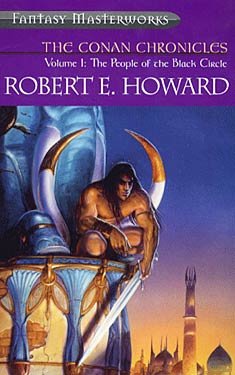Forays into Fantasy: Robert E. Howard’s Conan
Scott Lazerus is a Professor of Economics at Western State Colorado University in Gunnison, Colorado, and has been a science fiction fan since the 1970s. The Forays into Fantasy series is an exploration of the various threads of fantastic literature that have led to the wide variety of fantasy found today, from the perspective of an SF fan newly exploring the fantasy landscape. FiF will examine some of the most interesting landmark books of the past, along with a few of today’s most acclaimed fantasies, building up an understanding of the connections between fantasy’s origins, its touchstones, and its many strands of influence.
 Honestly, I didn’t think Robert E. Howard’s series of Conan stories, written and mostly published during the first half of the 1930s, would be of much interest to me. But given their importance as the tales that mark the beginning of a major subgenre that is still going strong today—what would come to be known as sword and sorcery—I thought my fantasy history tour would be incomplete without at least giving them a look. Given the continued popularity and influence of these stories, I should have known that there would be more to them than my preconceptions of a giant barbarian warrior with an equally giant sword hacking his way from one adventure to the next (not that there isn’t some truth to that description), and it turns out there are good reasons that Howard’s stories are considered central to the development of fantasy, and that the best of them are still interesting and enjoyable today.
Honestly, I didn’t think Robert E. Howard’s series of Conan stories, written and mostly published during the first half of the 1930s, would be of much interest to me. But given their importance as the tales that mark the beginning of a major subgenre that is still going strong today—what would come to be known as sword and sorcery—I thought my fantasy history tour would be incomplete without at least giving them a look. Given the continued popularity and influence of these stories, I should have known that there would be more to them than my preconceptions of a giant barbarian warrior with an equally giant sword hacking his way from one adventure to the next (not that there isn’t some truth to that description), and it turns out there are good reasons that Howard’s stories are considered central to the development of fantasy, and that the best of them are still interesting and enjoyable today.
One reason I hadn’t approached them before was my memory of the endless rows of Conan paperbacks on bookstore shelves while haunting the science fiction and fantasy sections during the 1970s, along with the multiple similar series, spinoffs, and even parodies. By that time, sword and sorcery had been stereotyped as the realm of muscular barbarians, scantily-clad damsels in distress, and escapist adventure, and the sheer repetitiveness of the cover images seemed to verify it. As it turns out, this reaction was unfair to Howard’s creation, which went through a long and confusing publishing history that in some ways took the character further and further from its origin in Howard’s stories.



















 Full Details
Full Details

